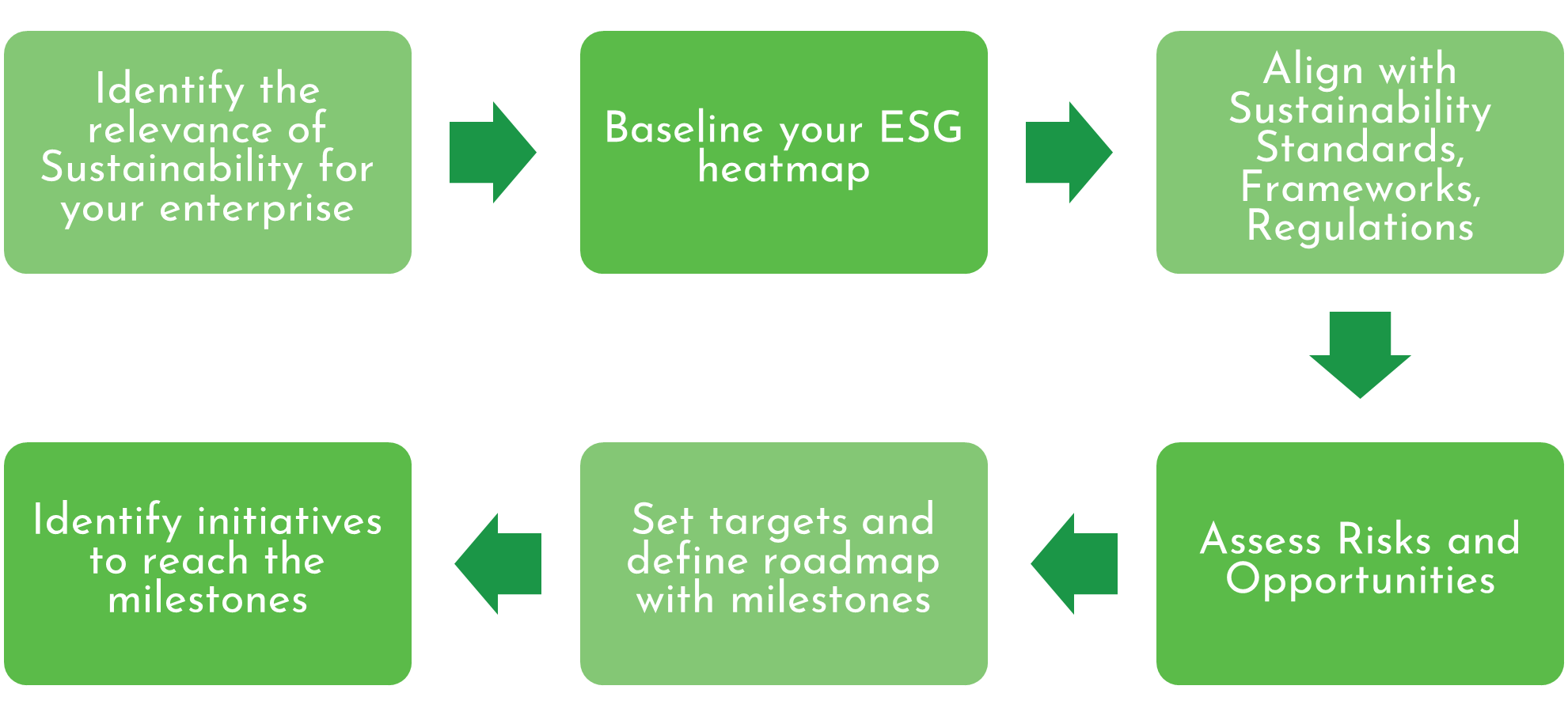
As enterprises start aligning themselves with Sustainability, they should do it in a manner that gives them the best chance of success. This success should find relevance in the minds of their stakeholders. While achieving these ambitions and making them relevant for their stakeholders could look goliath-like, it is important to draw plans that are modular, phased and progressive.
Enterprises do not achieve their Sustainability goals in a single leap; rather it takes multiple planned steps to get there. It is in this context that one needs to identify the right steps to take to reach the milestones along with roadmap, while keeping a firm eye on the end goal. We break the Planning phase into 6 steps, that will guide you.

1. Identify the relevance of Sustainability for your enterprise
Today, Sustainability has wide-ranging interpretations - Environment, Social, Governance, Financial – with each of them being relevant in the general sense. It is important to appreciate Sustainability from 3 lenses before drawing out the most relevant definition of Sustainability in your context. The 3 lenses are Sector Agnostic, Sector Specific and Entity-Specific. It is only when one looks at these 3 lenses will one be able to identify what is material for their enterprise. Our previous blog talked about how one could understand Sustainability before embarking on the journey.
In order to identify relevance of Sustainability for your enterprise through the 3 lenses approach, it is important to identify key stakeholders for your business. Follow this up with a materiality assessment exercise to narrow down and prioritize the most material (i.e important) topics for your key stakeholders.
2. Baseline your ESG heatmap
With the material topics identified, draw an assessment of your current performance against these. This is the opportunity to go granular on each identified topic and break them down into actionable items. For each actionable item, it is important to gather different voices to avoid bias in this baseline assessment. It would be ideal to have inputs from all your key stakeholders. At minimum, it should have the voice of the Senior Leadership across business functions – CEO, COO, CRO, CHRO, CFO, CMO, CSO, CSR Head, CTO etc.
Further, this step is also an opportunity to assess and arrive at your enterprise’s GHG emissions baseline across the operations. This will help in the further steps when targets and milestones will be determined.
Once these varying points of view have been identified and mapped, categorize the actionable items on a ESG heatmap to identify the ones that require priority attention over the others.
3. Align with Sustainability Standards, Frameworks, Regulations
With the completion of the baseline exercise and the identification of prioritized actions, explore how they align with recognized standards relevant to your business. While some of these could be regulatory like the BRSR, there is significant evolution and maturity in voluntary standards today; Ex: GRI, CDP, TCFD, IIRC, SASB etc.
It is important to also draw a sense of how your identified actions would help you get closer to the requirements of these standards, even if that was not your primary intent. For example, you may have decided to focus on Sustainability because of a regulation like BRSR in India. However, these regulations have drawn significantly from the mature global standards. So, in the process of ensuring BRSR compliance, you would have already made a strong case for your readiness for recognized global standards. Such readiness could give you a head start against your local and global competitors. It is this perspective that helps you have maximize your gains for the same effort.
4. Assess Risks and Opportunities
Changes in the external environment are inevitable. In fact, changes are far more frequent, now than ever – Political, Economic, Social, Technological, Environmental, Legal (PESTEL). The frequency of climate emergencies has also increased, causing disruptions in business operations across the value chain. The reality of the VUCA (Volatility, Uncertainty, Complexity and Ambiguity) world today is that constant, unpredictable changes are on the rise. At the same time, there is a growing scrutiny of business approach to risk management.
As an enterprise looking to adopt ESG (and even otherwise), please do consider Risk Identification, Analysis and Mitigation in your plans. The significance of every risk varies depending on the sector-specific and entity-specific parameters. It is important to assess each risk on its Level of Impact on your business, Likelihood of Occurrence and anticipated Time Horizon. A thorough comparative analysis of all risks would help determine the risks that need your prioritized attention.
A similar exercise should be considered to identify potential opportunities arising out of the changes in the external environment. The bottom line here is that not every external change has negative repercussions. Depending on the nature of your business, there is a potential for identification of opportunities arising out of these external factors. Drawing a parallel with Risk Analysis approach, each opportunity needs to be analysed on its Level of Benefit, Likelihood of Occurrence and Time Horizon.
5. Set targets and define roadmap with milestones
With all the analysis conducted in the previous steps, it is important to arrive at the enterprise’s appetite for Sustainability actions. It is obvious that every action identified will require considerable resources – time, financial, human, intellectual etc. It is, therefore, important to identify the actions along a roadmap, i.e. what should be taken up in the near term, medium term and long term? At the same time, one must be considerate of the fact that it is expected that companies are determining reduced emissions using the 1.5°C trajectory.
The Sustainability, ESG, Net Zero targets could be determined based on the above exercise. A long-term ambition needs to be drafted for communicating with your stakeholders. This long-term ambition needs to be broken down into smaller milestones for close monitoring of actual achievements to stay on course on the 1.5°C trajectory. It is important that your enterprise understands that achieving Climate Care and ESG maturity is progressive, and it requires considerable time. While setting out on the Sustainability roadmap, it is important to assess yourself against the global best practices and apply them judiciously in your actions.
6. Identify initiatives to reach the milestones
With the target and milestones identified, it is important to narrow down the specific projects/initiatives that will be taken up by your team A novel approach to identify these projects/initiatives is to engage your employees in a Design Thinking session. This approach brings in perspectives from employees across the hierarchy based on their operational experiences, and therefore brings out ideas that, when executed right, have the highest chance of success. Importantly, your employees also build a stronger connect with the organization’s push for Sustainability. This inclusive approach drives Sustainability culture across your workforce and brings down any potential internal resistance to change.
Another rule to be considered while identifying the projects/initiatives is that one should keep inadvertent greenwashing at bay. One of the key principles to adhere to is Mitigation Hierarchy. This states that any emission reduction approaches by an enterprise should sequentially avoid, reduce, remove and lastly offset. The idea is to get one’s own house in order before embarking on green projects outside.
Further, each identified initiative needs to be thoroughly studied for the expected outputs, outcomes and impacts after its implementation. A strong Monitoring and Evaluation (M&E) framework must be defined, and all involved stakeholders should have thoroughly understood it.
With these 6 steps done right, you have built the right platform for a confident take-off on your Sustainability journey. All that you are left to do is to put the plan to action and pursue your Sustainability, ESG, Net Zero roadmap.
